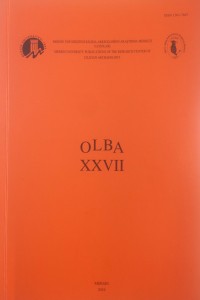Öz
The 2008 excavations at the Necropolis of Antandros yielded eight lekythoi, four amphoriskoi, two terracotta alabastra, mouth and body fragments of an alabastron made of alabaster and fragments of a bronze pin, all discovered inside the stone sarcophagus no. 271 dated to the Classical period. One of the terracotta alabastra stands out with its decoration scheme. It is a white-ground alabastron, depicting a human figure made in the outline technique, a palm tree and a stool. The scene is framed by a horizontal band above, and a thin ground line below. The upper vertical band consists of alternating broken meanders and saltire squares with a dot between the arms. The neck, shoulder and bottom are completely black glazed. The figure depicted on the alabastron has a frontal pose with legs in profile, standing barefoot; the head is not preserved. The arms are extended to the sides, holding a battle axe in the right hand and a bow in the left. A cloak hangs over the left arm and a large gorytos is at the waist. The head of the figure is not preserved due to damage; some fragments of the body are also missing. The figure is garbed in black glazed anaksyrides and a long-sleeved tunic. A white cloth covering the thighs is placed at the waist like an apron. The black-glazed garment is decorated with horizontal rows of white dots. Though worn at the most part, the dots are partly preserved on the anaksyrides and the long-sleeved tunic. The figure is barefoot; a second white color, different from the ground color, is used on the hands, feet, cloak and apron-like cloth at the waist. The white paint used on these parts has a yellowish hue. A palm tree with a stool before it is depicted in front of the figure. The vases included in the pottery group known in the literature as “Negro Alabastra” depict a negro with wooly hair, snub nose, thick lips and black skin and a second figure with long wavy hair and white skin. Generally, just one or sometimes both figures are depicted on the same vase. Debates among scholars on the identity and gender of these two figures have been ongoing since the middle of the 19th century. The general opinion is that the negro identifies with Memnon, leader of the Ethiopians who took part at the Trojan war or one of his followers, while the white skinned figure is regarded as Penthesilea, the Queen of the Amazons, or one of her attendants who also participated in the Trojan War. Regarding the genders, some scholars define both figures as male and others as female; some scholars go on to identify them both as Amazons. The figure on the example from Antandros appears to be white-skinned on account of the white paint preserved on the bare feet and hands, hence identified as an Amazon. Some scholars indicate that alabastra were mostly used by women and that the Amazon figure highlights the heroism of women. Very few bones were preserved in the sarcophagus where the example from Antandros was discovered, preventing the identification of a gender. Comparing the example from Antandros to similar vases, the pose of the figure, its anatomical features, clothing and the decorations on the outfit, the decorative patterns of saltire squares and meanders on the upper bordering band suggest that this vase must be the work of the Syriskos painter or a painter from his workshop. Additionally, similar examples of the lekythoi unearthed with the alabastron give a date between 480 and 460 BC.
Anahtar Kelimeler
Kaynakça
- Webster 1949 Webster, T. B. L., “Three İnterpretations of Greek Vases”, Memoirs and Proceedings of the Menchester Literary &Philosophical Society 89, 5-14. Winnefeld 1889 Winnefeld, H., “Alabastra Mit Negerdarstellungen”, Athenische Abteilung 14, 41-50.
Ayrıntılar
| Birincil Dil | İngilizce |
|---|---|
| Bölüm | Araştırma Makalesi |
| Yazarlar | |
| Yayımlanma Tarihi | 25 Temmuz 2019 |
| Yayımlandığı Sayı | Yıl 2019 Sayı: 27 |


